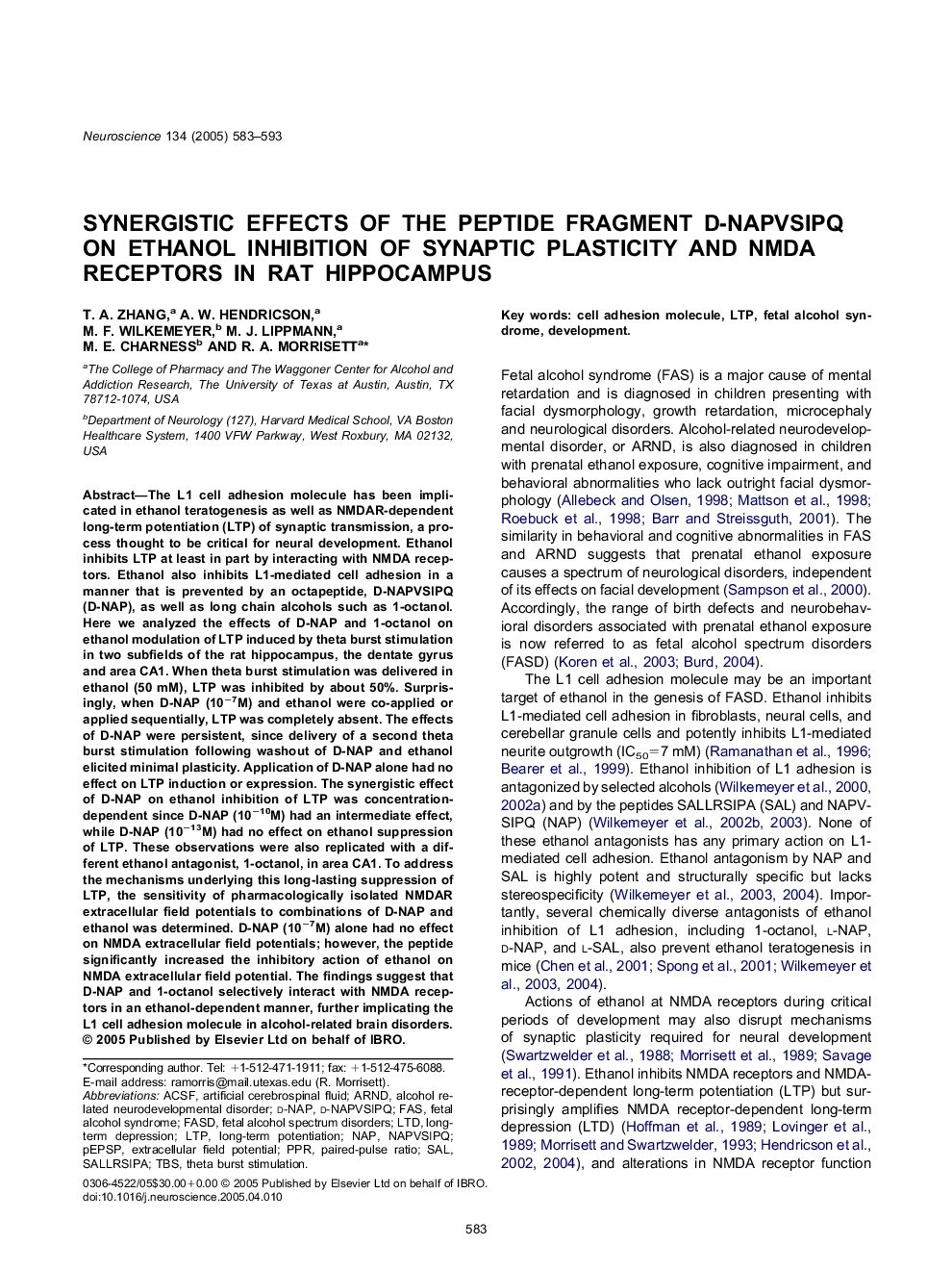| کد مقاله | کد نشریه | سال انتشار | مقاله انگلیسی | نسخه تمام متن |
|---|---|---|---|---|
| 9425739 | 1295889 | 2005 | 11 صفحه PDF | دانلود رایگان |
عنوان انگلیسی مقاله ISI
Synergistic effects of the peptide fragment D-NAPVSIPQ on ethanol inhibition of synaptic plasticity and NMDA receptors in rat hippocampus
دانلود مقاله + سفارش ترجمه
دانلود مقاله ISI انگلیسی
رایگان برای ایرانیان
کلمات کلیدی
PPRSALLRSIPApEPSPalcohol related neurodevelopmental disorderNAPVSIPQExtracellular field potentialARNDFASDaCSFTBSFASNAPSAL - WILLFetal alcohol spectrum disorders - اختلالات طیف الکل جنینlong-term depression - افسردگی طولانی مدتtheta burst stimulation - تحریک تئاتاlong-term potentiation - تقویت درازمدتLTP - تقویت طولانی مدت یا LTP Development - رشدFetal alcohol syndrome - سندرم جنینی الکلartificial cerebrospinal fluid - مایع مغزی نخاعی مصنوعیLTD - محدودCell adhesion molecule - مولکول چسبندگی سلولیpaired-pulse ratio - نسبت پالس زوج
موضوعات مرتبط
علوم زیستی و بیوفناوری
علم عصب شناسی
علوم اعصاب (عمومی)
پیش نمایش صفحه اول مقاله

چکیده انگلیسی
The L1 cell adhesion molecule has been implicated in ethanol teratogenesis as well as NMDAR-dependent long-term potentiation (LTP) of synaptic transmission, a process thought to be critical for neural development. Ethanol inhibits LTP at least in part by interacting with NMDA receptors. Ethanol also inhibits L1-mediated cell adhesion in a manner that is prevented by an octapeptide, D-NAPVSIPQ (D-NAP), as well as long chain alcohols such as 1-octanol. Here we analyzed the effects of D-NAP and 1-octanol on ethanol modulation of LTP induced by theta burst stimulation in two subfields of the rat hippocampus, the dentate gyrus and area CA1. When theta burst stimulation was delivered in ethanol (50mM), LTP was inhibited by about 50%. Surprisingly, when D-NAP (10â7M) and ethanol were co-applied or applied sequentially, LTP was completely absent. The effects of D-NAP were persistent, since delivery of a second theta burst stimulation following washout of D-NAP and ethanol elicited minimal plasticity. Application of D-NAP alone had no effect on LTP induction or expression. The synergistic effect of D-NAP on ethanol inhibition of LTP was concentration-dependent since D-NAP (10â10M) had an intermediate effect, while D-NAP (10â13M) had no effect on ethanol suppression of LTP. These observations were also replicated with a different ethanol antagonist, 1-octanol, in area CA1. To address the mechanisms underlying this long-lasting suppression of LTP, the sensitivity of pharmacologically isolated NMDAR extracellular field potentials to combinations of D-NAP and ethanol was determined. D-NAP (10â7M) alone had no effect on NMDA extracellular field potentials; however, the peptide significantly increased the inhibitory action of ethanol on NMDA extracellular field potential. The findings suggest that D-NAP and 1-octanol selectively interact with NMDA receptors in an ethanol-dependent manner, further implicating the L1 cell adhesion molecule in alcohol-related brain disorders.
ناشر
Database: Elsevier - ScienceDirect (ساینس دایرکت)
Journal: Neuroscience - Volume 134, Issue 2, 2005, Pages 583-593
Journal: Neuroscience - Volume 134, Issue 2, 2005, Pages 583-593
نویسندگان
T.A. Zhang, A.W. Hendricson, M.F. Wilkemeyer, M.J. Lippmann, M.E. Charness, R.A. Morrisett,